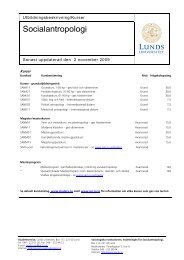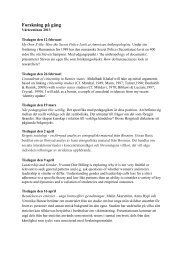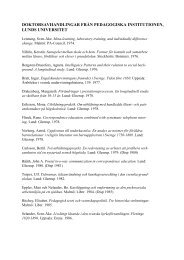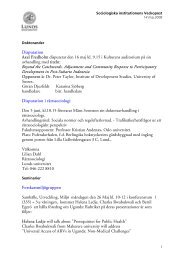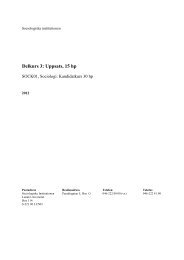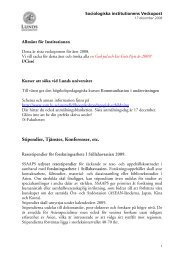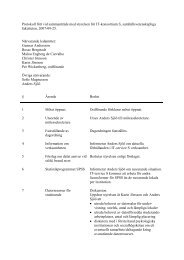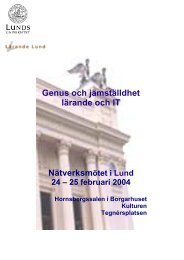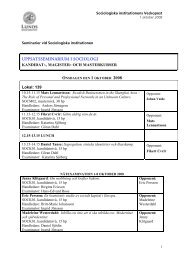Self, Belonging and Social Change
Self, Belonging and Social Change
Self, Belonging and Social Change
Create successful ePaper yourself
Turn your PDF publications into a flip-book with our unique Google optimized e-Paper software.
Article<br />
<strong>Self</strong>, <strong>Belonging</strong> <strong>and</strong><br />
<strong>Social</strong> <strong>Change</strong><br />
Sociology<br />
45(3) 363–378<br />
© The Author(s) 2011<br />
Reprints <strong>and</strong> permission: sagepub.<br />
co.uk/journalsPermissions.nav<br />
DOI: 10.1177/0038038511399624<br />
soc.sagepub.com<br />
Vanessa May<br />
University of Manchester, UK<br />
Abstract<br />
One of the central interests of sociology is the relationship between self <strong>and</strong> society, <strong>and</strong> in<br />
particular how social change affects individuality, constraining or liberating the selves that we can<br />
be. This article proposes that because a sense of belonging plays a central role in connecting the<br />
person to the social, it can act as a window into studying the relationship between social change<br />
<strong>and</strong> the self. Furthermore, belonging offers a complex person-centred <strong>and</strong> dynamic approach that<br />
avoids reifying social structures, but rather depicts them as actively lived. A focus on belonging<br />
thus allows a dynamic examination of the mutual influence between self <strong>and</strong> society, <strong>and</strong> of how<br />
everyday practices are both regulated <strong>and</strong> creative, <strong>and</strong> hence generative of social change.<br />
Keywords<br />
belonging, self, social change<br />
Introduction<br />
One of the central interests of sociology is the relationship between self <strong>and</strong> society. This<br />
article examines whether the concept of belonging can bring something new to sociologists’<br />
attempts to underst<strong>and</strong> the link between the self <strong>and</strong> the social, in particular the<br />
effects of social change on our selves. This article begins by examining two sociological<br />
accounts on social change that have come to dominate the discipline. The first posits that<br />
modernity has led to psychosocial fragmentation, while the second maintains that the<br />
conditions of modernity have increased people’s capacity for reflexivity. This article<br />
addresses two central weaknesses of these theses. First, their view of the past as ‘fixed’<br />
<strong>and</strong> stable compared with a fluid <strong>and</strong> unpredictable present is misguided (Burkitt, 2004;<br />
Williams, 1977). Second, they depict ‘society’ as an entity entirely separate from the<br />
‘self’, <strong>and</strong>, in so doing, prioritize the role of social structures in their accounts of social<br />
Corresponding author:<br />
Vanessa May, Department of Sociology, Arthur Lewis Building, University of Manchester,<br />
Oxford Road, Manchester M13 9PL, UK.<br />
Email: vanessa.may@manchester.ac.uk
364 Sociology 45(3)<br />
change. However, as Simmel (1950) <strong>and</strong> Elias (2001) have pointed out, self <strong>and</strong> society<br />
are mutually constitutive <strong>and</strong> therefore cannot be examined separately.<br />
In light of these criticisms of the psychosocial fragmentation <strong>and</strong> extended reflexivity<br />
theses, the self is here taken as the starting point in order to examine the interconnections<br />
between social structures <strong>and</strong> the self, as well as the impact that social change has on our<br />
selves. In doing so, I draw inspiration from the sociology of everyday life <strong>and</strong> the sociology<br />
of personal life. The former examines how people engage with pre-existing social<br />
structures in both regulated <strong>and</strong> creative ways (e.g. De Certeau, 1984), while the latter<br />
underst<strong>and</strong>s human life as comprised of complex, interconnected spheres, <strong>and</strong> selves as<br />
connected to other people as well as culturally <strong>and</strong> socially embedded (Smart, 2007).<br />
Furthermore, I propose that belonging is an apt concept for studying this relationship<br />
between the self <strong>and</strong> society for four reasons. First, it is person-centred; second, it takes us<br />
into the everyday where the official <strong>and</strong> unofficial spheres interact; third, it allows us to<br />
view the relationship between self <strong>and</strong> society as complex; <strong>and</strong> fourth, its dynamic nature<br />
allows us to examine social change. But first, I briefly outline the key elements of the two<br />
dominant sociological accounts on the effects that social change has on our selves.<br />
Sociology on <strong>Social</strong> <strong>Change</strong><br />
The first storyline that seems to repeatedly surface within sociology is one depicting the<br />
evils of social change, wreaking havoc on individual people <strong>and</strong> communities alike. To<br />
name just a few of the most famous, we have Marx’s (e.g. Marx <strong>and</strong> Engels, 1977[1845])<br />
account of how the forces of capitalism had alienated people not only from society but<br />
also from themselves. Some decades later, Tönnies (1963[1887]) offered his narrative of<br />
the shift from the cozy <strong>and</strong> dependable Gemeinschaft to the rather less comforting<br />
Gesellschaft, followed by Durkheim’s (1984[1893]) version, which was similar in tone,<br />
focusing on the shift from mechanistic to organic solidarity that in its extreme leads to<br />
anomie. Fast-forward to the latter half of the 20th century, <strong>and</strong> we encounter theorists<br />
such as Riesman (1961), Lasch (1978), Sennett (1998), Putnam (2000) <strong>and</strong> Furedi (2004)<br />
who have all offered similarly gloomy accounts of modernity, warning us of the dire<br />
psychological consequences of the loss of traditions <strong>and</strong> old certainties that is turning us<br />
into other-directed, self-obsessed, helpless <strong>and</strong> fragmented persons, which in turn is<br />
eroding trust, social cohesion <strong>and</strong> community.<br />
These are but a sample of works that are part of what Adams (2007) terms the psychosocial<br />
fragmentation thesis. According to Frow, this virtually theological discourse on<br />
modernity characterizes contemporary life as ‘the loss of significant totality, the fall into<br />
repetition’ (2002: 632). Such nostalgic accounts that juxtapose contemporary society<br />
with the world we have lost <strong>and</strong> that we hope to redeem have also been readily picked up<br />
in popular debates.<br />
A quite different story is offered by the now equally canonical extended reflexivity<br />
thesis that highlights the liberating effects of social change. According to Giddens<br />
(1991), as our lives have been disembedded from tradition <strong>and</strong> old contexts, the self has<br />
become a reflexive project no longer determined by social position. Consequently, people<br />
now face both the new freedoms <strong>and</strong> the new challenges or uncertainties that this<br />
reflexivity entails. Similarly, Beck (1992) has argued that the loss of old certainties
May 365<br />
means that people are left to craft their own biographies. Beck is, however, more cautious<br />
than Giddens in his pronouncements regarding the freedom for maneouvre that<br />
people have <strong>and</strong> points out that with increased institutionalization <strong>and</strong> st<strong>and</strong>ardization<br />
of, for example, the educational system <strong>and</strong> the labour market, our lives are now structured<br />
according to new institutional biographical patterns (Beck, 1992: 131–2). This<br />
account of extended reflexivity has also clearly resonated with both sociologists <strong>and</strong> the<br />
general public.<br />
The aim of this rather crude overview of social theory, which glosses over the tensions<br />
<strong>and</strong> complexities included in the theorists’ work, is to point to two related aspects that<br />
seem prevalent in both accounts of social change. First, past societies tend to be presented<br />
as more fixed than present ones. Second, ‘society’ <strong>and</strong> ‘individual’ are depicted as<br />
two separate spheres, emphasizing the role that social structures play in shaping our<br />
lives. These points are addressed in more detail below.<br />
Fixed <strong>Social</strong> Structures of the Past Versus<br />
a Fluid Personal Sphere in the Present?<br />
What unites the two sociological accounts that were briefly described above is their<br />
depiction of the past <strong>and</strong> the present as distinctly different. The past is characterized by<br />
stable <strong>and</strong> clearly identifiable social structures that strongly determined individual lives,<br />
which were consequently more predictable than contemporary lives (Williams, 1977).<br />
In contrast, when social theorists turn their gaze to the society of their day, they tend to<br />
see constant change that unsettles any such moorings, securities or certainties. As a<br />
result, they can end up depicting the present as fluid <strong>and</strong> in the making, <strong>and</strong> as somewhat<br />
chaotic <strong>and</strong> formless (Burkitt, 2004: 220).<br />
Adam critiques the dualism of such ‘before-<strong>and</strong>-after analyses of fixed states, established<br />
retrospectively’ <strong>and</strong> proposes that tradition has not been replaced by ‘reflexivity,<br />
disorder, flux <strong>and</strong> uncertainty’, but that these co-exist, which is why it is their ‘mutual<br />
implication’ that should be the focus of social theory (1996: 135). Thompson (1996)<br />
argues that such analyses are also based on the misconception that traditions are fixed<br />
<strong>and</strong> pre-given, when in fact they are always open to change <strong>and</strong> flexible. In sum, traditions<br />
have not disappeared, but rather remain important features of contemporary societies<br />
though their nature <strong>and</strong> role may have shifted (1996: 94).<br />
Such romanticized interpretations of the past are partly based on the optical illusion<br />
created by viewing past societies through social structures, which are easily seen as<br />
fixed <strong>and</strong> stable, while theorists’ vantage point into the present is often through the<br />
personal, which appears malleable (Burkitt, 2004). This leads me onto the second critique<br />
of the individualization <strong>and</strong> psychosocial fragmentation theses: they distinguish<br />
‘social structures’ <strong>and</strong> ‘the personal’ as two separate <strong>and</strong> inherently different spheres.<br />
<strong>Social</strong> structures are depicted as semi-permanent fixtures that exist over <strong>and</strong> above<br />
people, imposed upon them <strong>and</strong> determining who they can be (Burkitt, 2004: 212;<br />
Williams, 1977). Conversely, the personal is equated with ‘everyday life’, which in turn<br />
is constructed in essentializing terms, creating a myth of ‘ordinary’ everyday life<br />
(S<strong>and</strong>ywell, 2004: 174). Contrary to this perceived difference between ‘social structures’<br />
(the official sphere) <strong>and</strong> ‘the personal’ (the unofficial sphere), they are in fact
366 Sociology 45(3)<br />
more similar than such views allow; interdependent <strong>and</strong> permeable, each affected by<br />
the other (Burkitt, 2004; S<strong>and</strong>ywell, 2004; Williams, 1977).<br />
<strong>Self</strong> <strong>and</strong> Society as Mutually Constitutive<br />
It is here that I turn to Simmel (1950) <strong>and</strong> Elias (2001) who both proposed that because<br />
neither self nor society can be understood independently of each other, sociologists<br />
should be focusing on the relationship between them. Simmel (1950: 9–10) depicted<br />
society as an event, as something that individuals do, rather than a concrete substance,<br />
<strong>and</strong> consequently he used the term ‘sociation’ in preference to ‘society’. Thus he presented<br />
interaction as a key element of the social, <strong>and</strong> argued that sociologists should not<br />
confine themselves to studying large social formations alone because less conspicuous<br />
forms of relationship <strong>and</strong> interaction are also significant (1950: 9). In addition, this article<br />
argues that society is also made up of how people relate to their material environment<br />
as well as to more abstract or symbolic notions such as ‘society’, shared cultural norms,<br />
traditions <strong>and</strong> values.<br />
Elias similarly warned against thinking of either society or the individual as more<br />
important than the other, because society could not exist without individuals, while individuals<br />
do not exist separate from society. Instead, he urged sociologists to examine the<br />
relationship between them:<br />
… to underst<strong>and</strong> them [individuals <strong>and</strong> society] it is necessary to give up thinking in terms of<br />
single, isolated substances <strong>and</strong> to start thinking in terms of relationships <strong>and</strong> functions. (2001: 19)<br />
Simmel proposed that the ‘interaction between individuals is the starting point of all<br />
social formations’ (1990: 174) <strong>and</strong> that ‘society’ comes about as the result of some<br />
actions becoming permanent <strong>and</strong> crystallized as definable <strong>and</strong> consistent structures such<br />
as state, family <strong>and</strong> class that assume a logic <strong>and</strong> independence of their own (1950: 9).<br />
Thus social structures should not be viewed as reified entities but rather as sedimented<br />
practices resulting from fixing ‘in geographical space <strong>and</strong> in codified language the relational<br />
forms <strong>and</strong> activities of the past’ (Burkitt, 2004: 220). This fixing can have both<br />
material manifestations (e.g. the distribution of wealth in society) <strong>and</strong> intangible consequences<br />
(e.g. ways of thinking or social norms) (Young, 2005: 20).<br />
When sociologists abstract the social, however, they debar it as relevant or significant<br />
to the immediate (Williams, 1977: 129). Yet our everyday practices occur in the context<br />
of <strong>and</strong> are affected by these sedimented ways of thinking <strong>and</strong> doing things (Burkitt,<br />
2004; De Quieroz, 1989). Although we recognize social forms more easily when they are<br />
articulated <strong>and</strong> explicit, <strong>and</strong> therefore appear ‘fixed’ <strong>and</strong> permanent, they only become a<br />
part of social consciousness if they are ‘lived, actively, in real relationships’ (Williams,<br />
1977: 130). These social structures are meaningful in people’s lives because they ‘constitute<br />
the historical givens in relation to which individuals act <strong>and</strong> which are relatively<br />
stable over time’ (Young, 2005: 20).<br />
Although social structures are the aggregate result of many individual interactions<br />
<strong>and</strong> change as the result of ‘the confluence of many individual actions within given institutional<br />
relations’ (Young, 2005: 20), we can rarely if ever reduce them to the conscious
May 367<br />
intentions of one person or group of people (Elias, 2001; Young, 2005: 20). Bourdieu<br />
speaks in similar terms of the ‘structuring structure’ of ‘habitus’ as ‘collectively orchestrated<br />
without being the product of the orchestrating action of a conductor’ (1977: 72).<br />
Furthermore, social change cannot be predicted because it is the combined result of individual<br />
people reacting to new situations in, to some degree, idiosyncratic rather than<br />
completely patterned <strong>and</strong> predictable ways (Bourdieu, 1977: 73; Elias, 2001: 63–4).<br />
There thus exists a constant <strong>and</strong> complex loop between individual (inter)action <strong>and</strong><br />
social change, both affecting each other.<br />
Personal Lives in the Everyday<br />
Such an underst<strong>and</strong>ing of the nature of social change requires a dynamic approach that<br />
examines the creative ways in which people interact with pre-existing social structures.<br />
Two sociological approaches, the first focusing on everyday life, <strong>and</strong> the second on<br />
personal life, offer us the conceptual tools to do so.<br />
When trying to underst<strong>and</strong> the relationship between self <strong>and</strong> society, one of the best<br />
places to start is in everyday life, where the official <strong>and</strong> the unofficial spheres of activity<br />
<strong>and</strong> thought intersect (Burkitt, 2004). An interest in the everyday means focusing on ‘the<br />
very close, the familiar, <strong>and</strong> the habitual’ (Harrison, 2000: 497) as well as on a form of<br />
consciousness that is habitual <strong>and</strong> distracted (Felski, 2002: 607). Everyday life, however,<br />
encompasses both routine repetition of past behaviours as well as creative actions that<br />
help change what is regarded as ‘commonplace’ (McCracken, 2002: 147). Consequently,<br />
the sociology of everyday life views social reality not as a static or an a-historic finished<br />
product but rather as emergent, as something that is forever fluid, dynamic <strong>and</strong> ‘almostnot-quite’<br />
(Harrison, 2000: 501; S<strong>and</strong>ywell, 2004: 165). Furthermore, a focus on the<br />
everyday allows us to view social change not simply as a top-down process generated by<br />
‘extraordinary’ events but as something that also results from our mundane ‘ordinary’<br />
activities <strong>and</strong> from the tactics (De Certeau, 1984) that people use to negotiate their way<br />
through or around social structures.<br />
This article also borrows conceptual tools from the sociology of personal life as<br />
developed by Smart (2007). The term ‘personal’, which Smart uses instead of the more<br />
atomistic ‘individual’, highlights the connectedness <strong>and</strong> social embeddedness of people’s<br />
lives; people are ‘embedded in both sedimented structures <strong>and</strong> the imaginary’<br />
(2007: 28–9). This interest in the role that ‘traditions’ <strong>and</strong> ‘social structures’ on the one<br />
h<strong>and</strong> <strong>and</strong> creativity on the other play in our lives is something that the sociology of personal<br />
life shares with the sociology of everyday life, <strong>and</strong> further helps overcome the<br />
distinction between ‘the unofficial’ <strong>and</strong> ‘the official’ spheres. Personal life is ‘lived in<br />
many different places <strong>and</strong> spaces [... ] <strong>and</strong> it forms a range of connections’ (Smart,<br />
2007: 29). In addition, a personal life approach focuses on life projects, <strong>and</strong> is therefore<br />
able to portray a sense of motion in people’s lives, brought about by events such as<br />
unemployment or processes such as ageing that transform our lives.<br />
<strong>Belonging</strong> is here presented as a concept that allows for a person-centred, dynamic<br />
<strong>and</strong> complex approach <strong>and</strong> that underst<strong>and</strong>s people as active participants in society. In<br />
the remainder of this article, four aspects of belonging which make it particularly useful<br />
for studying the interrelatedness of self <strong>and</strong> social change are discussed in some detail.
368 Sociology 45(3)<br />
First, a focus on belonging allows us to study the links between ‘the self’ <strong>and</strong> ‘society’<br />
from the point of view of the person <strong>and</strong>, second, to examine how people engage with<br />
social structures in their everyday lives. Third, a sense of belonging is complex, encompassing<br />
our relational, cultural <strong>and</strong> sensory connections. Fourth, the concept of belonging<br />
lends itself well to the study of social change because our experiences of belonging<br />
are dynamic <strong>and</strong> sensitive to changes. In the ensuing discussion, examples from empirical<br />
studies on belonging from a wide range of disciplines including sociology, geography,<br />
cultural studies <strong>and</strong> design studies are offered as illustration.<br />
<strong>Belonging</strong> Links the Person with the <strong>Social</strong><br />
<strong>Belonging</strong> is here defined as a sense of ease with oneself <strong>and</strong> one’s surroundings. Miller<br />
proposes that belonging is ‘the quintessential mode of being human [... ] in which all<br />
aspects of the self, as human, are perfectly integrated – a mode of being in which we are<br />
as we ought to be: fully ourselves’ (2003: 218), while Baumeister <strong>and</strong> Leary argue that<br />
the need to belong is ‘a powerful, fundamental, <strong>and</strong> extremely pervasive motivation’<br />
(1995: 497). <strong>Belonging</strong> is thus a crucial aspect of being a person: it is ‘fundamental to<br />
who <strong>and</strong> what we are’ (Miller, 2003: 217). <strong>Belonging</strong> involves a process of creating a<br />
sense of identification with one’s social, relational <strong>and</strong> material surroundings (Miller,<br />
2003), or ‘of recognising – or misrecognising – the self in the other’ (Leach, 2002: 287).<br />
As Weeks says: ‘Identity is about belonging, about what you have in common with some<br />
people <strong>and</strong> what differentiates you from others’ (1990: 88).<br />
Thus belonging plays a role in connecting individuals to the social. This is important<br />
because our sense of self is constructed in a relational process in our interactions with<br />
other people as well as in relation to more abstract notions of collectively held social<br />
norms, values <strong>and</strong> customs. These social origins of the self have been the particular focus<br />
of the symbolic interactionist school of thought. The Meadian ‘me’ assumes a set of<br />
social attitudes <strong>and</strong> is consequently able to imagine how a ‘generalised other’ would see<br />
its actions <strong>and</strong> to evaluate these in light of the group’s norms (Mead, 1934), while the<br />
Goffmanian self employs (unwritten) social rules to present a moral self (Goffman,<br />
1959). Bourdieu’s theory of habitus also encompasses these social rules of engagement.<br />
He talks about mastery of ‘the game’within a particular social field – knowing what to<br />
do, how <strong>and</strong> when (Bourdieu, 1977: 161, 1979: 250–1, 330).<br />
A sense of belonging is indeed partly achieved on the basis of knowing these unwritten<br />
rules <strong>and</strong> being able to conduct oneself in an ‘acceptable’ manner before others<br />
(Fortier, 2000). We can make claims for belonging by citing shared underst<strong>and</strong>ings of<br />
who ‘we’ are <strong>and</strong> how ‘we’ behave (Bell, 1999b; Fortier, 2000). Yet what is lacking in the<br />
accounts above is a sense of where these collective rules come from, or how they develop.<br />
As Shotter (1993) argues, a sense of belonging is not built merely on the existence of a<br />
collectively shared culture, but requires also the right to participate in the development<br />
of the ‘living tradition’ or the reflexive arguments of that society:<br />
… that is, arguments about what should be argued about, <strong>and</strong> why. [... ] to be able to feel that in<br />
doing so one is contributing to one’s own world, one must be able to participate in the argument.<br />
(Shotter, 1993: 193)
May 369<br />
This is the intersubjective element that Bottero proposes is missing from Bourdieu’s<br />
concept of habitus, which is characterized by an ‘abstract emphasis on objective structural<br />
relations’ (2009: 401). Murphy further develops these arguments by criticizing<br />
Bourdieu for privileging ‘relations between social positions at the expense of exploring<br />
the substance of these positions’ <strong>and</strong> for neglecting ‘the emotional content of familial <strong>and</strong><br />
communal relations’ (forthcoming: 105–6). As Skeggs’s (1997) <strong>and</strong> Sayer’s (2005) work<br />
shows, people experience their social position <strong>and</strong> their intersubjective ties as drenched<br />
with emotion <strong>and</strong> morality. ‘<strong>Belonging</strong>’ differs from ‘habitus’ because it is a relational<br />
concept that necessarily focuses on social interaction <strong>and</strong> intersubjectivity, <strong>and</strong> the<br />
emotional content of these.<br />
Intersubjectivity is important exactly because the collective underst<strong>and</strong>ings on which<br />
we build our sense of belonging are not merely ‘the result of individuals internalising their<br />
shared conditions in the same fashion’ but are rather negotiated accomplishments (Bottero,<br />
2009: 413–14). For example, the women interviewed by Fenster (2005: 227–8) in<br />
Jerusalem <strong>and</strong> London expressed the right to participate in decision-making <strong>and</strong> the right<br />
to choose, for example, where to live, how to decorate one’s home or how to use public<br />
space, as necessary in order to achieve a sense of belonging. The South African people<br />
who had experienced forced removals during Apartheid expressed similar sentiments<br />
when interviewed by McEachern (1998): not having the right to choose where to live had<br />
meant that they had lost part of their identity <strong>and</strong> their sense of belonging in the city:<br />
These people were [... ] forced into a racialised kind of suburbia, a mode of living <strong>and</strong> an identity<br />
which was not of their own choosing. And in doing so they lost a significant element of their<br />
identity as South Africans. They lost their right to determine their own identities. (1998: 514)<br />
The quote from McEachern above exemplifies how inclusion in the reflexive arguments<br />
of a society or in collective decision-making is not an automatic right in any society;<br />
some people find themselves on the margins or excluded. Because shared cultures <strong>and</strong><br />
values, or underst<strong>and</strong>ings of who ‘we’ are <strong>and</strong> what ‘we’ st<strong>and</strong> for, are the result of struggles<br />
over representation <strong>and</strong> membership, they tend to reflect power structures <strong>and</strong> serve<br />
the interests of those in power (e.g. Miller, 2003; Probyn, 1996; Shotter, 1993; Weedon,<br />
2004; Williams, 1977: 115–17). There exist, in other words, hierarchies of belonging, <strong>and</strong><br />
not everyone is allowed to belong. <strong>Belonging</strong> is therefore more than just an individual<br />
feeling – it is also a hotly contested political issue with collective consequences (Weedon,<br />
2004). For example, in contemporary Britain, ethnic minority people may find their<br />
claims for British identity rejected (Eade, 1994; Ifekwunigwe, 1999; Weedon, 2004).<br />
<strong>Belonging</strong> can thus have both an emotional component of ‘feeling at home’ or ‘yearning<br />
for a home’, <strong>and</strong> a political element of claim-making for space <strong>and</strong> for recognition (Bell,<br />
1999a; Miller, 2003; Scheibelhofer, 2007: 321).<br />
<strong>Belonging</strong> in the Everyday<br />
A sense of belonging is based on everyday habits (Jackson, 1983: 334). <strong>Belonging</strong> is an<br />
appropriate concept for studying the relationship between social change <strong>and</strong> the self<br />
precisely because it brings us into the territory of the everyday where the ‘official’ <strong>and</strong>
370 Sociology 45(3)<br />
‘unofficial’ spheres intersect. This is the phenomenological world of Schütz’s (1962)<br />
‘natural attitude’, of everyday practices that, although constitutive of social order, remain<br />
largely in the realm of the taken for granted <strong>and</strong> the ‘seen but unnoticed’ (Garfinkel,<br />
1967: 180). <strong>Belonging</strong> can therefore be understood as an everyday mode of being that is<br />
largely unconscious or not the focus of conscious thought (Felski, 2002). In other words,<br />
one of the ways in which a sense of belonging can emerge is if we can go about our everyday<br />
lives without having to pay much attention to how we do it.<br />
Conversely, a disruption in our everyday environment can make us feel uprooted<br />
(Jackson, 1983: 328). When our expectations of the everyday are not met, when we cannot<br />
go about our mundane tasks as we are accustomed to, <strong>and</strong> when we become consciously<br />
aware of our habitual ways of being <strong>and</strong> doing, we can awaken to a feeling of<br />
not belonging. It is from this lack of fit that a sense of unease, of not belonging, emerges.<br />
This sense of not belonging will be examined in more detail later on in the article.<br />
Once again there is a similarity between belonging <strong>and</strong> Bourdieu’s notion of habitus.<br />
According to Bourdieu (1979: 171–2), our habitus fits a specific social field <strong>and</strong> as long<br />
as we remain in this field we are not necessarily aware of our habitus, but rather, it feels<br />
‘natural’ to us. What the concept of belonging allows us to do that habitus does not is to<br />
underst<strong>and</strong> how people can be embedded in a familiar everyday world yet feel that they<br />
do not belong there. As discussed above, belonging is an intersubjective experience that<br />
necessarily involves other people. We make claims for belonging which others either<br />
reject or accept, <strong>and</strong> therefore, mere familiarity with a place, a group of people or a culture<br />
is not enough for us to gain a sense of belonging.<br />
Bourdieu’s analysis has further been critiqued for being structurally deterministic:<br />
because habitus are viewed as the result of structure, they have no movement of their<br />
own – habitus only change as a result of changing structures (De Certeau, 1984: 57–8).<br />
Conceptualizing belonging as rooted in the everyday allows for a dynamic picture of<br />
two-way influence between structures <strong>and</strong> everyday habits (cf. Burkitt, 2004). Although<br />
social structures help shape who we are, our actions are not completely determined by<br />
them; we do have scope for microresistant tactics that contribute to socio-structural<br />
change (cf. Felski, 2002: 612; De Certeau, 1984: 40).<br />
<strong>Belonging</strong> is Multidimensional<br />
The third reason why belonging lends itself to the study of the interlinking of self <strong>and</strong><br />
social change is that it is a multidimensional experience that interweaves many aspects<br />
of our being in the world. This is crucial because the self is also multifaceted, comprising<br />
age, gender, ethnicity, sexuality, religion, education, occupation, hobbies, cultural tastes,<br />
<strong>and</strong> more. Furthermore, during the course of our lives we come into contact with many<br />
different people, social contexts <strong>and</strong> places. Consequently, few of us feel a sense of<br />
belonging merely to one group, culture or place but rather experience multiple senses of<br />
belonging. For example, people of mixed heritage or migrants may experience manifold,<br />
<strong>and</strong> at times contradictory, senses of belonging (Ifekwunigwe, 1999). Eade (1994: 386)<br />
found that second-generation Bangladeshi Muslims living in Britain could formulate<br />
complex national, regional <strong>and</strong> religious belongings. Many saw their different forms of<br />
belonging as competing, <strong>and</strong> reconciled this by constructing ‘composite, hierarchically
May 371<br />
ordered identities’ (Eade, 1994: 391). In her study of an Italian immigrant community in<br />
London, Fortier uses the phrase ‘migrant belongings’ in order to capture ‘the productive<br />
tension that results from the articulation of movement <strong>and</strong> attachment, suture <strong>and</strong> departure,<br />
outside <strong>and</strong> inside, in identity formation’ (2000: 2). She argues that immigrant populations<br />
vacillate between ‘national identity’ <strong>and</strong> ‘émigré identity’, producing a ‘cultural<br />
citizenship that is grounded in multilocality’ (2000: 97).<br />
A further multidimensional aspect of belonging is that, in addition to people <strong>and</strong> collective<br />
ideas, we also construct a sense of belonging to places <strong>and</strong> material objects<br />
(Downing, 2003: 213; Fortier, 2000; Savage et al., 2005). In this aspect, habitus once<br />
more covers some of the same terrain as belonging. In her study of Italian immigrants,<br />
Fortier (2000) uses Bourdieusian terms to describe how people experience a sense of<br />
belonging in spaces where there is a correspondence between their body hexis <strong>and</strong> the<br />
social field. Such habitual spaces feel familiar to us <strong>and</strong> we know instinctively what to<br />
do <strong>and</strong> how to behave just by stepping into them (e.g. churches).<br />
What the concept of belonging offers, however, that habitus does not sufficiently<br />
take into consideration is an underst<strong>and</strong>ing of how our connections with our natural<br />
<strong>and</strong> built environments are sensory (Friedmann, 2002). We come to know the world<br />
through our sensuous embodied experiences of touch, sound, smell <strong>and</strong> taste that help<br />
us achieve ‘a holistic way of underst<strong>and</strong>ing three-dimensional space’ (O’Neill, 2001: 3).<br />
From a phenomenological point of view, it can be argued that our knowledge of the<br />
world ‘is not just a matter of thought about the world, but stems from bodily presence<br />
<strong>and</strong> bodily orientation in relation to it, bodily awareness’ (Tilley, 1994: 14, emphasis<br />
in original). As we regularly walk or move through places, we create our own spatial<br />
routes through them (Bendiner-Viani, 2005: 462). By means of such habitual timespace<br />
routines, or ‘place-ballets’ (Seamon, 1980), we become familiar with the contours<br />
of the l<strong>and</strong>scape, as well as with its typical smells, sights <strong>and</strong> sounds (O’Neill,<br />
2001). In De Certeau’s (1984) terms, we ‘territorialise’ space by moving through it <strong>and</strong><br />
in doing so we make space ‘our own’. In other words, we build a sense of belonging in<br />
the world based on the meanings we give our environment by moving through <strong>and</strong><br />
engaging with it (Leach, 2002: 286).<br />
This engagement with <strong>and</strong> sense of belonging to place is fundamental to our sense of<br />
self (Leach, 2002: 286). Tilley proposes that our individual <strong>and</strong> cultural identities are<br />
‘bound up with place’ <strong>and</strong> that we create a sense of self ‘through place’ (1994: 15). When<br />
identifying with a place, we mirror ourselves with our surroundings: we ‘introject’ the<br />
external environment into us, while we also ‘project’ or read ourselves onto the external<br />
world (Leach, 2002: 288). In sum, we go through a process of ‘making sense of place,<br />
developing a feeling of belonging <strong>and</strong> eventually identifying with that place’ (Leach,<br />
2002: 292), <strong>and</strong> in this process we come to underst<strong>and</strong> who we are, both as individuals<br />
<strong>and</strong> as a group of people:<br />
The place acts dialectically so as to create the people who are out of that place. These qualities<br />
of locales <strong>and</strong> l<strong>and</strong>scapes give rise to a feeling of belonging <strong>and</strong> rootedness <strong>and</strong> a familiarity,<br />
which is not born just out of knowledge, but of concern that provides ontological security.<br />
They give rise to a power to act <strong>and</strong> a power to relate that is both liberating <strong>and</strong> productive.<br />
(Tilley, 1994: 26)
372 Sociology 45(3)<br />
Tilley’s argument about the link between belonging <strong>and</strong> the ability to act echoes that of<br />
Shotter (1993), that is, that belonging is not merely a state of mind but is bound up with<br />
being able to act in a socially significant manner that is recognized by others.<br />
<strong>Belonging</strong> is the Result of Dynamic Practices<br />
We have so far seen how a sense of belonging is achieved by being <strong>and</strong> doing in the<br />
world. This means that belonging is not a static state as indicated by Heideggerian<br />
notions of ‘dwelling’ <strong>and</strong> that territorialization is not necessarily about fixed roots, but<br />
about something more transitory <strong>and</strong> fluid (Leach, 2002: 286). <strong>Belonging</strong> can in<br />
other words be depicted as a trajectory through time <strong>and</strong> space (de Certeau, 1984). Our<br />
sense of belonging changes over time, partly in response to changes in our self. For<br />
example, becoming a parent can lead to a person developing a stronger sense of<br />
belonging to a locality (Fenster, 2005; Savage et al., 2005). Parents find themselves<br />
engaging both in new routines such as taking children to the playground, nursery or<br />
school, <strong>and</strong> new interactions with other parents <strong>and</strong> with teachers, which serve to connect<br />
them to a locality in a novel way (Savage et al., 2005: 54). Fenster (2005: 223)<br />
found similarly in her study that, after becoming mothers, women started using<br />
their local neighbourhood <strong>and</strong> its services such as shops <strong>and</strong> of course schools<br />
more intensely, <strong>and</strong> consequently felt a stronger sense of belonging or attachment to<br />
their area.<br />
Our relational <strong>and</strong> cultural surroundings are also likely to undergo changes, which<br />
further contribute to shifts in our sense of belonging. Savage <strong>and</strong> colleagues (2005), for<br />
example, found that ‘born <strong>and</strong> bred’ residents of an area could experience a sense of not<br />
belonging if the sociodemographic profile of the area changed, for example if newcomers<br />
represented a different class or lifestyle. Furthermore, material transformations are an<br />
important part of social change, as witnessed in any major city, such as Manchester,<br />
where hundreds of years of industrial <strong>and</strong> social developments have left their mark on the<br />
physical contours of the city (Edensor, 2007). Any significant changes in our material<br />
surroundings will have an impact on our sense of belonging: as old forms of belonging<br />
such as urban architecture disappear or decay <strong>and</strong> new infrastructures are built, people<br />
are faced with having to make new connections, re-building their sense of belonging<br />
(Adams et al., 2007; Edensor, 2007).<br />
<strong>Belonging</strong> is, in other words, not a given or something that we accomplish once <strong>and</strong><br />
for all. Because the world <strong>and</strong> the people in it, including ourselves, are constantly undergoing<br />
change, belonging is something we have to keep achieving through an active process<br />
(Bell, 1999a: 3; Miller, 2003: 223; Scheibelhofer, 2007). Thus belonging offers an<br />
apt window into studying the interconnectedness of social change <strong>and</strong> the self – as the<br />
world around us changes, so does our relationship to it.<br />
Is <strong>Belonging</strong> an Ideal State?<br />
<strong>Belonging</strong> is of course a concept that for many people is laden with positive connotations.<br />
If belonging is understood as a sense of ease with one’s surroundings, then arguably not<br />
belonging can be characterized as a sense of unease. In other words, our sense of
May 373<br />
‘ontological security’ (Giddens, 1991) is shaken as our immediate social context becomes<br />
less predictable or comfortable for us, <strong>and</strong> we no longer feel that we ‘fit’ with our surroundings.<br />
Most people would probably assume this ontological insecurity to be an<br />
undesirable state. For example, Shotter argues that being excluded from the language<br />
<strong>and</strong> reflexive arguments of a society ‘is to live in a world not one’s own’ (1993: 195),<br />
which in turn can have a damaging effect on our sense of self (cf. Weedon, 2004).<br />
Failing to identify with a place can also have negative consequences, such as placepanic<br />
where ‘we confront the imminent possibility of there being no place to be or to<br />
go’, feel without place <strong>and</strong> estranged, <strong>and</strong> experience symptoms such as homesickness,<br />
disorientation, depression, desolation, or ‘a sense of unbearable emptiness’ (Casey,<br />
1993: x). Casey points out that displacement <strong>and</strong> losing a connection with place is not<br />
solely the experience of those in exile, but in one shape or other all of us in today’s<br />
‘speed-bound era’ will feel it at various times in relation to our locality, city, region,<br />
culture or the world. According to Casey (1993: 307), such ‘place-alienation’ has a profound<br />
effect on people’s sense of who they are. An alteration in place leads to an alteration<br />
in self, <strong>and</strong> those who are alienated from place may feel ‘other than’ themselves<br />
(Casey, 1993: 308).<br />
A health warning is however in order at this point, lest we start idealizing belonging<br />
<strong>and</strong> arguing that not belonging is inherently harmful. A feeling of not belonging need not<br />
always be experienced negatively. For many of us, there exists a tension between wanting<br />
to be similar to <strong>and</strong> belong with others, <strong>and</strong> wanting to be unique <strong>and</strong> different from<br />
others (Elias, 2001; Simmel, 1971). More importantly, this tension can be productive.<br />
Indeed, some people seek a sense of not belonging for example by changing place<br />
through travel (Casey, 1993: 308–9), perhaps in order to ‘broaden their minds’. It is at<br />
the moment when dispositional habitus is disrupted that reflexivity is awakened (Bottero,<br />
2010: 8), which can also be understood as something akin to Lefebvre’s (2002)<br />
‘moments’ or Benjamin’s (1999) ‘shock experiences’ that disrupt the smooth flow of<br />
everyday experience <strong>and</strong> of the taken for granted. Such fractures or joins can make us<br />
take note of our surroundings in a new <strong>and</strong> potentially productive way by allowing us to<br />
realize the ‘rich <strong>and</strong> manifold possibilities that are presented to us at given historical<br />
conjunctures’ (Gardiner, 2004: 243) <strong>and</strong> to see ‘what could be’ rather than just ‘what is’<br />
(McCracken, 2002: 151).<br />
In other words, a sense of not belonging can open up new possibilities of, for example,<br />
political action if we become conscious of the fact that the routine paths we have so<br />
far traversed are not the only possible ones. Indeed, some identities such as the<br />
Quebecois identity may be constructed on the margins or outside of dominant belongings<br />
(Probyn, 1996; Stychin, 1997). Stychin (1997: 33–5) further argues that the questioning<br />
of borders <strong>and</strong> membership by groups such as non-heterosexuals can be<br />
conducive to the development of ‘deep diversity’ where identities are not predetermined<br />
or totalizing but rather flexible <strong>and</strong> open to multiple belongings. Such resistance<br />
to belonging has also led to the development of new narratives of identity, such as narratives<br />
of lesbian identity, which have provided people with ‘new material possibilities<br />
<strong>and</strong> social positions’ (Duggan, 1993). Not belonging does not in other words have to<br />
have purely negative consequences, just as belonging is not necessarily a positive thing<br />
or an ideal state.
374 Sociology 45(3)<br />
Conclusion<br />
This article has been engaging with the question of what people’s everyday sense of<br />
belonging to their relational, cultural <strong>and</strong> material contexts might say about the interconnection<br />
between self <strong>and</strong> social change. I suggest that a focus on belonging provides an<br />
alternative to top-down structural theorizing that is characterized by a focus on how<br />
changes in society require people to adapt. In contrast, because of both its location in the<br />
everyday realities of people <strong>and</strong> its dynamic nature, belonging is a concept that allows us<br />
to examine the mutual interaction between social change <strong>and</strong> the self. The social is thus<br />
here defined not in terms of abstract social structures or a reified ‘culture’, but as something<br />
made up of the concrete, imagined or virtual relationships we have with people,<br />
collectives, the symbolic or abstract realm of ‘cultures’, objects, as well as our built <strong>and</strong><br />
natural environments.<br />
When viewed from the perspective of the everyday, the world does not change<br />
unbeknownst to us; we do not simply wake up one morning to find the world changed<br />
beyond recognition. Rather, change tends to be constant <strong>and</strong> incremental <strong>and</strong> is introduced<br />
piecemeal into our lives in the form of, for example, new technologies, new institutional<br />
practices, new forms of ‘culture’ <strong>and</strong> the changing requirements of the<br />
work-place. Furthermore, many theorists such as Marx, Durkheim, Giddens <strong>and</strong> Beck<br />
attribute a certain directionality <strong>and</strong> coherence to social change. However, as experienced<br />
by individuals, these changes do not appear to embody an overarching logic, <strong>and</strong><br />
it is usually only with hindsight that we can identify a ‘gr<strong>and</strong> narrative’ that allows us to<br />
underst<strong>and</strong> different developments as interconnected <strong>and</strong> as part of a broader thing called<br />
‘social change’ that has transformed our society in a particular direction. Simmel (1971)<br />
argues that it is because we are involved in many different groups <strong>and</strong> move through different<br />
spheres of life, <strong>and</strong> are consequently not shaped by one single force but by many,<br />
that we do not experience the wholeness of our lives but rather see our existence in such<br />
a fragmentary way (Levine, 1971: xxxviii). Similarly, we experience <strong>and</strong> respond to<br />
social change in a fragmentary fashion.<br />
People’s reaction to much of social change tends to therefore come in the form of<br />
gradual alterations in (some aspect of) their habits, routines <strong>and</strong> ways of thinking. We are<br />
faced with practical choices such as whether to start using a computer rather than a typewriter<br />
or whether to contact NHS Direct online rather than calling in at a doctor’s surgery.<br />
Some choices are not ours to make – we might have to walk that extra mile to the<br />
nearest post office, start using electronic ticketing machines <strong>and</strong> swipe-cards, shop at a<br />
supermarket some miles distant if we no longer have access to a local butcher <strong>and</strong> baker,<br />
<strong>and</strong> so on. And by so adopting new ways of behaving <strong>and</strong> thinking, or resisting them,<br />
people contribute to further social transformations.<br />
A focus on belonging allows us to examine who is allowed to take part in the reflexive<br />
arguments that contribute to changes in society, who is excluded from these <strong>and</strong> on which<br />
grounds, <strong>and</strong> the effects that such inclusion <strong>and</strong> exclusion have on people’s sense of self.<br />
In other words, it is important to explore how a sense of belonging can be achieved <strong>and</strong><br />
by whom. <strong>Belonging</strong> should, however, not be seen as automatically superior to not<br />
belonging. Not belonging can in fact be the more productive of the two in terms of social<br />
change if, as a result of questioning who ‘we’ are, people construct alternative identities
May 375<br />
<strong>and</strong> ways of life. Thus it is also crucial to examine who does not belong, <strong>and</strong> how<br />
experiences of not belonging help contribute to social change.<br />
It is here that I return to Simmel’s <strong>and</strong> Elias’s arguments that self <strong>and</strong> society cannot<br />
be regarded as two separate entities. As Simmel (1950: 7–9) points out, if we view the<br />
world up-close, we see individual persons <strong>and</strong> their characteristics, but as we move further<br />
away our perspective changes <strong>and</strong> the individuals disappear, <strong>and</strong> what we see instead<br />
is society. We interpret this as seeing two separate entities, but both are in fact views of<br />
the same thing seen differently depending on our distance from it. Elias (2001) similarly<br />
points out that society should not be viewed as something separate from the relationships<br />
that constitute it. While the structural accounts of social change posit a distinction<br />
between the self <strong>and</strong> society comparable to the Cartesian inner-outer split, Simmel <strong>and</strong><br />
Elias could be interpreted as saying that in as much as society consists of people, we are<br />
all ‘out there’ in society. To paraphrase Merleau-Ponty (1962), who argues that perception<br />
is a mode of being in the world rather than a question of spectating an external<br />
world, I argue that the self is a mode of being in society rather than something separate<br />
from society. We do not merely spectate a society or participate in it. We are in it, we are<br />
it. And one of the ways in which we experience this being in society is through our sense<br />
of belonging or lack thereof. A focus on belonging can thus offer a window into studying<br />
the complexities of the interrelationship between change on both the personal <strong>and</strong> the<br />
social level.<br />
Acknowledgements<br />
I am very grateful to the two anonymous reviewers for their helpful comments. I would also like<br />
to thank the audience members at the Turning Personal conference organized by the Morgan<br />
Centre for the Study of Relationships <strong>and</strong> Personal Life in 2009 for their positive encouragement<br />
of an early draft of this article.<br />
References<br />
Adam B (1996) Detraditionalization <strong>and</strong> the certainty of uncertain futures. In: Heelas P (ed.)<br />
Detraditionalization: Critical Reflections on Authority <strong>and</strong> Identity. Oxford: Blackwell,<br />
134–48.<br />
Adams M (2007) <strong>Self</strong> <strong>and</strong> <strong>Social</strong> <strong>Change</strong>. London: Sage.<br />
Adams M, Moore G, Cox T, Croxford B, Refaee M <strong>and</strong> Sharples S (2007) The 24-hour city:<br />
Residents’ sensorial experiences. Senses & Society 2(2): 201–16.<br />
Baumeister RF <strong>and</strong> Leary MR (1995) The need to belong: Desire for interpersonal attachments as<br />
a fundamental human motivation. Psychological Bulletin 117(3): 497–529.<br />
Beck U (1992) Risk Society: Towards a New Modernity. London: Sage.<br />
Bell V (1999a) Performativity <strong>and</strong> belonging: An introduction. Theory, Culture & Society 16(2):<br />
1–10.<br />
Bell V (1999b) On speech, race <strong>and</strong> melancholia: An interview with Judith Butler. Theory, Culture<br />
& Society 16(2): 163–74.<br />
Bendiner-Viani G (2005) Walking, emotion, <strong>and</strong> dwelling: Guided tours in Prospect Heights,<br />
Brooklyn. Space <strong>and</strong> Culture 8(4): 459–71.<br />
Benjamin W (1999) The Arcades Project (trans. Eil<strong>and</strong> H <strong>and</strong> McLaughlin K). Cambridge, MA:<br />
Belknap Press.<br />
Bottero W (2009) Relationality <strong>and</strong> social interaction. British Journal of Sociology 60(2): 399–420.
376 Sociology 45(3)<br />
Bottero W (2010) Intersubjectivity <strong>and</strong> Bourdieusian approaches to ‘identity’. Cultural Sociology<br />
4(1): 3–22.<br />
Bourdieu P (1977) Outline of a Theory of Practice. Cambridge: Cambridge University Press.<br />
Bourdieu P (1979) Distinction: A <strong>Social</strong> Critique of the Judgement of Taste. London: Routledge.<br />
Burkitt I (2004) The time <strong>and</strong> space of everyday life. Cultural Studies 18(2): 211–27.<br />
Casey ES (1993) Getting Back Into Place: Toward a Renewed Underst<strong>and</strong>ing of the Place-World.<br />
Bloomington, IN: Indiana University Press.<br />
De Certeau M (1984) The Practice of Everyday Life (trans. Rendall S). Berkeley, CA: University<br />
of California Press.<br />
De Quieroz JM (1989) The sociology of everyday life as a perspective. Current Sociology 37(1):<br />
31–9.<br />
Downing F (2003) Transcending memory: Remembrance <strong>and</strong> the design of place. Design Studies<br />
24: 213–35.<br />
Duggan L (1993) The trials of Alice Mitchell: Sensationalism, sexology, <strong>and</strong> the lesbian subject in<br />
turn-of-the-century America. Signs 18(4): 791–814.<br />
Durkheim E (1984[1893]) The Division of Labor in Society (trans. Halls WD). New York: Free<br />
Press.<br />
Eade J (1994) Identity, nation <strong>and</strong> religion: Educated young Bangladeshi Muslims in London’s<br />
‘East End’. International Sociology 9: 377–94.<br />
Edensor T (2007) Sensing the ruin. Senses & Society 2(2): 217–32.<br />
Elias N (2001) The Society of Individuals. New York: Continuum.<br />
Felski R (2002) Introduction. New Literary History 33(4): 607–22.<br />
Fenster T (2005) The right to the gendered city: Different formations of belonging in everyday life.<br />
Journal of Gender Studies 14(3): 217–31.<br />
Fortier AM (2000) Migrant <strong>Belonging</strong>s: Memory, Space, Identity. Oxford: Berg.<br />
Friedmann J (2002) Placemaking as project? Habitus <strong>and</strong> migration in transnational cities. In:<br />
Hillier J <strong>and</strong> Rooksby E (eds) Habitus: A Sense of Place. Aldershot: Ashgate, 299–316.<br />
Frow J (2002) ‘Never draw to an inside straight’: On everyday knowledge. New Literary History<br />
33(4): 623–37.<br />
Furedi F (2004) Therapy Culture: Cultivating Vulnerability in an Uncertain Age. London:<br />
Routledge.<br />
Gardiner ME (2004) Everyday utopianism. Cultural Studies 18(2): 228–54.<br />
Garfinkel H (1967) Studies in Ethnomethodology. Englewood Cliffs, NJ: Prentice-Hall.<br />
Giddens A (1991) Modernity <strong>and</strong> <strong>Self</strong>-identity: <strong>Self</strong> <strong>and</strong> Society in the Late Modern Age.<br />
Cambridge: Polity.<br />
Goffman E (1959) The Presentation of <strong>Self</strong> in Everyday Life. New York: Doubleday.<br />
Harrison P (2000) Making sense: Embodiment <strong>and</strong> the sensibilities of the everyday. Environment<br />
<strong>and</strong> Planning D: Society <strong>and</strong> Space 18: 497–517.<br />
Ifekwunigwe JO (1999) Scattered <strong>Belonging</strong>s: Cultural Paradoxes of ‘Race’, Nation <strong>and</strong> Gender.<br />
London: Routledge.<br />
Jackson M (1983) Knowledge of the body. Man (New Series) 18(2): 327–45.<br />
Lasch C (1978) The Culture of Narcissism: American Life in an Age of Diminishing Expectations.<br />
New York: Norton.<br />
Leach N (2002) <strong>Belonging</strong>: Towards a theory of identification with space. In: Hillier J <strong>and</strong> Rooksby<br />
E (eds) Habitus: A Sense of Place. Aldershot: Ashgate, 281–95.<br />
Lefebvre H (2002) Critique of Everyday Life Vol. II: Foundations for a Sociology of the Everyday<br />
(trans. Moore J). London: Verso.<br />
Levine DN (1971) Introduction. In: Levine DN (ed.) On Individuality <strong>and</strong> <strong>Social</strong> Forms. Chicago:<br />
University of Chicago Press, ix–xv.
May 377<br />
McCracken S (2002) The completion of old work: Walter Benjamin <strong>and</strong> the everyday. Cultural<br />
Critique 52(Autumn): 145–66.<br />
McEachern C (1998) Mapping the memories: Politics, place <strong>and</strong> identity in the District Six<br />
Museum, Cape Town. <strong>Social</strong> Identities 4(3): 499–521.<br />
Marx K <strong>and</strong> Engels F (1977[1845]) The German Ideology, Part One (ed. <strong>and</strong> intro. Arthur CJ).<br />
London: Lawrence & Wishart.<br />
Mead GH (1934) Mind, <strong>Self</strong> <strong>and</strong> Society: From the St<strong>and</strong>point of a <strong>Social</strong> Behaviorist. Chicago:<br />
University of Chicago Press.<br />
Merleau-Ponty M (1962) Phenomenology of Perception (trans. Smith C). London: Routledge &<br />
Kegan Paul.<br />
Miller L (2003) <strong>Belonging</strong> to country – A philosophical anthropology. Journal of Australian<br />
Studies 27(76): 215–23.<br />
Murphy M (forthcoming) The ties that bind: Distinction, recognition <strong>and</strong> the relational.<br />
International Journal of Interdisciplinary <strong>Social</strong> Sciences 5(10): 103–16.<br />
O’Neill ME (2001) Corporeal experience: A haptic way of knowing. Journal of Architectural<br />
Education 55(1): 3–12.<br />
Probyn E (1996) Outside <strong>Belonging</strong>s. New York: Routledge.<br />
Putnam RD (2000) Bowling Alone: The Collapse <strong>and</strong> Revival of American Community. New York:<br />
Simon & Schuster.<br />
Riesman D (with Glazer N <strong>and</strong> Denney R) (1961) The Lonely Crowd: A Study of the Changing<br />
American Character. New Haven, CT: Yale University Press.<br />
S<strong>and</strong>ywell B (2004) The myth of everyday life. Cultural Studies 18(2): 160–80.<br />
Savage M, Bagnall G <strong>and</strong> Longhurst B (2005) Globalization <strong>and</strong> <strong>Belonging</strong>: The Suburbanization<br />
of Identity. London: Sage.<br />
Sayer A (2005) The Moral Significance of Class. Cambridge: Cambridge University Press.<br />
Scheibelhofer P (2007) His-stories of belonging: Young second-generation Turkish men in<br />
Austria. Journal of Intercultural Studies 28(3): 317–30.<br />
Schütz A (1962) Collected Papers I: The Problem of <strong>Social</strong> Reality (ed. <strong>and</strong> intro. Natanson M).<br />
The Hague: Martinus Nijhoff.<br />
Seamon D (1980) Body-subject, time-space routines, <strong>and</strong> place-ballets. In: Buttimer A <strong>and</strong> Seamon<br />
D (eds) The Human Experience of Space <strong>and</strong> Place. London: Croom Helm, 148–65.<br />
Sennett R (1998) The Corrosion of Character: The Personal Consequences of Work in the New<br />
Capitalism. New York: Norton.<br />
Shotter J (1993) Cultural Politics of Everyday Life. Buckingham: Open University Press.<br />
Simmel G (1950) The field of sociology. In: Wolff G (ed. <strong>and</strong> trans.) The Sociology of Georg<br />
Simmel. New York: The Free Press, 3–25.<br />
Simmel G (1971) The metropolis <strong>and</strong> mental life. In: Levine DN (ed.) On Individuality <strong>and</strong> <strong>Social</strong><br />
Forms. Chicago: University of Chicago Press, 324–39.<br />
Simmel G (1990) The Philosophy of Money, 2nd edn (trans. Bottomore T <strong>and</strong> Frisby D). London:<br />
Routledge.<br />
Skeggs B (1997) Formations of Class <strong>and</strong> Gender: Becoming Respectable. London: Sage.<br />
Smart C (2007) Personal Life: New Directions in Sociological Thinking. Cambridge: Polity.<br />
Stychin CF (1997) Queer nations: Nationalism, sexuality <strong>and</strong> the discourse of rights in Quebec.<br />
Feminist Legal Studies 1(1): 3–34.<br />
Thompson JB (1996) Tradition <strong>and</strong> self in a mediated world. In: Heelas P (ed.) Detraditionalization:<br />
Critical Reflections on Authority <strong>and</strong> Identity. Oxford: Blackwell, 89–108.<br />
Tilley C (1994) A Phenomenology of L<strong>and</strong>scape: Places, Paths <strong>and</strong> Monuments. Oxford: Berg.<br />
Tönnies F (1963[1887]) Community <strong>and</strong> Society (trans. <strong>and</strong> ed. Loomis CP). New York: Harper &<br />
Row.
378 Sociology 45(3)<br />
Weedon C (2004) Identity <strong>and</strong> Culture: Narratives of Difference <strong>and</strong> <strong>Belonging</strong>. Maidenhead:<br />
Open University Press.<br />
Weeks J (1990) Coming Out: Homosexual Politics in Britain from the Nineteenth Century to the<br />
Present, rev. edn. London: Quartet Books.<br />
Williams R (1977) Marxism <strong>and</strong> Literature. Oxford: Oxford University Press.<br />
Young IM (2005) On Female Body Experience: ‘Throwing Like a Girl’ <strong>and</strong> Other Essays. Oxford:<br />
Oxford University Press.<br />
Vanessa May is Lecturer in Sociology at the University of Manchester <strong>and</strong> a member of<br />
the Morgan Centre for the Study of Relationships <strong>and</strong> Personal Life. Her research interests<br />
include the self, belonging, lone motherhood, post-divorce parenting, intergenerational<br />
relationships, narrative analysis, biographical methods <strong>and</strong> mixed methods. Her<br />
work has been published in Sociology, Sociological Review, Women’s Studies International<br />
Forum, International Journal of <strong>Social</strong> Research Methodology <strong>and</strong> Narrative Inquiry,<br />
among others. She is currently working on a book entitled Connecting <strong>Self</strong> <strong>and</strong> Society:<br />
<strong>Belonging</strong> in a Changing World, to be published by Palgrave.<br />
Date submitted February 2010<br />
Date accepted August 2010




